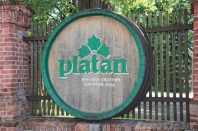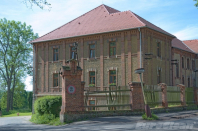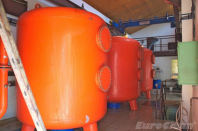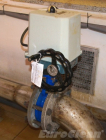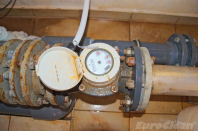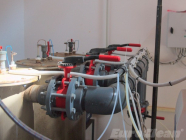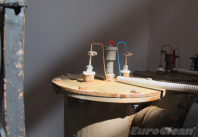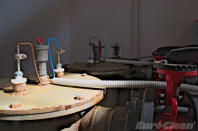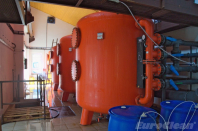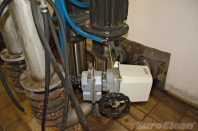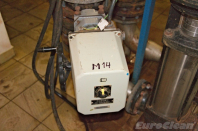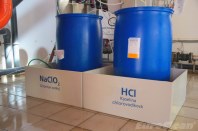
Reconstruction of the water treatment plant in the Platan Brewery
EuroClean’s s.r.o. solution in Protivín modernizes and simplifies the process of raw water treatment to make it drinkable. The request of the customer is accepted and comes from the optiom of using the current functional device. That is done by using the mechanical parts, which haven’t been damaged. Unfunctional and outdated components are replaced by new ones, fully responding to new legislative standards, or they are completely discharged as not necessary.
Description of the treatment plant
The treatment plant serves to treat raw water from the underground drills to make it drinkable and therefore appropriate for beer production.
Raw drill water is lead through three paralell electrolyzers into two serial aeration containers. On the way there is chlordioxide (ClO2) added to the pipes, which is prepared in the OXCL generator.
From the aeration containers the water is ran trough the reactor, where another intensive aeration takes place, to the sump of aerated water by gravity.
From there it is pusched through four sand filters by two paralell pumps where iron (Fe) and manganese (Mn) are being separated and water flows into a sump of drinkable water. From this sump the treated drinkable water is pushed by two paralell pumps to the so called Observatory and to the waste pump (as water to be used to cleaning of the sand filters) and then by gravity to the canalization.
Generator of chlordioxide OXCL
Solution of chlorine dioxide is prepared from a solution of sodium chlorite diluted with drinking water and hydrochloric acid, which displaces chlorous acid from its salt and adjusts the pH of the solution. Chlorous acid is unstable and a decay products are then chlorine dioxide and chlorine. Chlorine reacts with sodium chlorite and the products are chlorine dioxide and sodium chloride.
NaClO2 + HCL → NaCl + HClO2
8 HClO2 → 6 ClO2 + Cl2 + 4 H2O
Cl2 + 2NaClO2 → 2 ClO2 + 2 NaCl
Chlorine dioxide is an irritating yellow-green gas with a characteristich stench.
When manipulating chemicals it is always necessary to use appropriate safety tools and following the safety protocols – see Safety Lists and Emergency Rules of OXCL.
Electrolytical water treatment plant consists of a stainless steel skeleton with struts and flange provided with pressure gland for DC power supply, and a vent valve. The glands contain an electrode system which is formed by a set of anodes and cathodes. Electrode system is powered by the SELF power supply.
NaOH dosing pump 50%
Dosing pump IWAKI EWN serves to dose NaOH 50% for rising of the pH of the treated water. Consumption of the treated water has to be observed by daily measuring and if needed, the dose needs to be adjusted in dependence of the temperature of the dosed medium. Dosing hose is provided with heating cable with a thermostat. If the outside temperature gets below 5 °C, it is necessary to provide a daily check of the heating cable functionality.
When manipulating NaOH 50% it is necessary to use safety tools and follow the security protocols.
Sand filters
Sand filters with the SILHORKO controls. Flush of the filter 1x a day cca 40 minutes. Attendant does a daily visual check of the tightness of all connections and 1x a week of the functionality of all additive devices (blowers, pneumatic controls, pumps). Filtration is slowed by the outlet shutter.
Aeration containers, aeration
2x aeration container. Attendant manages daily visual check of the tightness of the pumps and functionality of the aeration. Quarterly then de-sedimentation of the containers and a check of the aeration nozzles on the bottom of the containers. When outside temperature gets below 5°C, it is necessary to check the functionality of heating cables on a daily basis to ensure that there is no frost! In case of emergency it is possible to lead the inlet straight to the containers and stop it from entering the device.
Reactor
Reactor consists of pipes DN300 made of PVC-U. Attendant manages daily visual check of the tightness of the seams.
